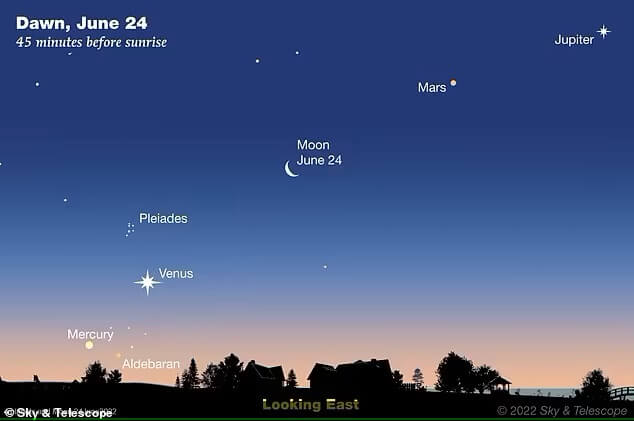
For The First Time In 18 Years, 5 Planets And The Moon Are About To Line Up In The Sky
This month, five planets visible to the naked eye are aligning in the sky in a "special" parade that hasn't been seen for 18 years.
By David Nield | Science Alert
Through June, sky watchers have had the pleasure of watching all five of the planets that we can see with the naked eye – Mercury, Venus, Mars, Jupiter, Saturn – line up in the sky. And this weekend, the crescent Moon will join them.
Impressively, the planets currently appear in order of their distance from the Sun, from left to right as you scan the horizon: that means starting with Mercury (an average of 58 million kilometres or 36 million miles from the Sun) and ending with Saturn (an average of 1.4 billion kilometres or 886 million miles from the Sun).
Across the weekend, the waning crescent Moon should show up between Venus and Mars (you could even think of it as a stand-in for Earth).
Mercury will be clearly visible on June 27 as well, making it easier for you to spot it before working your way to the right along the horizon. On this particular morning, the planetary show should be visible for about an hour.
This type of planetary alignment – known as a conjunction – hasn’t happened since December 2004, and won’t happen again until 2040.
The show will be visible towards the eastern horizon just before the Sun rises and obscures the view. In the Northern Hemisphere, look towards the east and the south; in the Southern Hemisphere, look towards the east and the north.
Best of all, it’s all visible with the naked eye, although of course you can look closer with binoculars or a telescope.
This conjunction has been in the works for a while: you might remember that Saturn, Mars, Venus, and Jupiter were lined up in the sky during the month of April. It’s all a trick of perspective of course – but these are stunning sights to observe.
These events and the visibility of the planets may vary in terms of dates depending on where you are in the world. There should be plenty of opportunity for everyone to see the five planets though, even if you get a few cloudy days.
This article was originally published by Science Alert.
